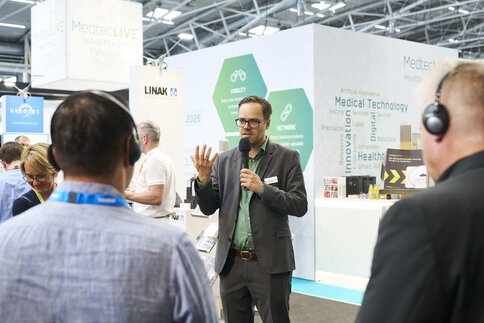Focus on healthcare automation
All growth projections for robotic systems in pharmaceuticals, medical science, and healthcare point the same way: straight up. Mordor Intelligence expects the market value to cross 31 billion USD by 2030, corresponding to an average annual growth of more than 19 percent. That was more than enough reason for automatica 2025 to put a spotlight on this promising market.
Within this context, the trade fair organizers developed an impactful concept made up of three complementary components: the MedtecSUMMIT in collaboration with Bayern Innovativ, the MedtecLIVE Healthtech Pavillon in cooperation with NürnbergMesse, and exhibits by automatica exhibitors that had been curated by VDMA Healthtech.
While visitors had the opportunity to get informed about a wide range of topics presented by medical experts, scientists, and industry representatives at the summit, various exhibitors from the medical technology supplier sector put a spotlight on the entire value chain of this growth market at the MedtecLIVE Healthtech Pavillon. The daily guided tours offered by VDMA Healthtech were also very well received by visiting professionals as they covered the most important exhibitors and exhibits for various fields of application.


Robots for aseptic environments
“Our three-pronged healthtech concept has been a great success. Our visiting professionals showed huge interest, which underlines the significance of this promising market for the automation sector. And our exhibitors went all out, of course. They presented visionary robotics, cobot, and mobile robotics solutions for healthtech applications as well as innovative assembly plants for medical devices”, as Anja Schneider, automatica Exhibition Director, emphasizes.
A number of premium manufacturers presented the advanced status quo in automation with their hygienically engineered robots that can even be deployed in sterile environments. Their fields of application include cell and gene therapy (CGT), biotherapy, API research and production, as well as lab automation. Of course these pharma robots also meet all cleaning and decontamination requirements involving hydrogen peroxide.
AI revolutionizes healthtech applications
automatica also highlighted the great potential benefit of artificial intelligence to robot deployments in the fields of medicine and pharmaceuticals. AI increases the flexibility, precision, and safety of robotics applications in labs, pharmaceutical logistics, or directly on the patient’s bedside—and unlocks many use cases that wouldn’t be possible without it. It enables real-time processing of large data quantities, recognizes patterns, and makes adaptive decisions. Andreas Däubler, CTO of the Munich-based AI specialist robominds, explains: “AI turns robots into smart assistants that provide meaningful support to professionals and set new quality benchmarks”.
Some initial projects demonstrate the potential: robominds was able to automate the sorting and preparation stage of blood samples for downstream analysis using AI-powered bin picking—a task requiring extreme accuracy. Another project involved the development of a mobile robot reliably picking samples in another lab environment—similar use cases might include tasks such as medicine distribution in hospitals.
‘Futurelab’ by the Hamburg-based start-up bAhead is a demonstration of how the future has taken hold in laboratories. Its purpose is to unlock highly efficient and cost-effective AI-powered lab automation. Rainer Treptow, CEO and founder of bAhead, explains: “We were the first to combine three disruptive technologies for lab use—cobots, drones, and AI. All system components are cost-efficient, multi-functional, and work perfectly in tune as they are controlled using swarm intelligence. This creates entirely different dynamics than in conventional lab automation, especially in labs facing the challenge of automating small sample quantities.”
Robert rehab robot supports nursing staff
The Robert® robot has an entirely different mission. It is responsible for making patients mobile again as they recover from a surgical intervention or stroke. “With our solution, we want to help mobilize patients faster and more efficiently while easing the burden on nursing staff,” states Keld Thorsen, CEO of Life Science Robotics.
And this is how Robert works: The nurse attaches the robot arm to the patient’s leg, for example. Pressing the start button causes Robert to raise the leg slightly. Now the nurse can manually perform the therapeutic movements. Robert memorizes this movement so that it can then perform it independently exactly as demonstrated and as often as required.
Mobile robots advance into aseptic environments
Automation of some other healthcare application fields can only be achieved using mobile robots. This includes helping persons requiring assistance, but also extends to new concepts for transport and handling tasks in the pharma factory of the future. A number of automatica exhibitors presented visionary AGV and AMR solutions for such tasks, including a very special premiere: Stäubli Robotics presented the world’s first mobile robot certified for use in sterile environments—a milestone in automating the pharmaceutical industry.

“Messe München’s healthtech initiative was a resounding success for Stäubli and many other exhibitors. The exhibition’s focal point was perfectly highlighted and met all our expectations. We hope for a repetition at automatica 2027”, said Peter Pühringer, Managing Director of Stäubli Robotics in Bayreuth. And this is something Anja Schneider can already confirm: “The healthtech focal point was a real highlight for visiting professionals, exhibitors, and us organizers alike. Thus, optimizing the concept based on feedback collected at the 2025 event and doing it again is kind of a must.”
Text: Ralf Högel on behalf of Messe München
